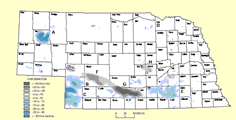Natural Resources, School of

Conservation and Survey Division: Faculty and Staff Publications
ORCID IDs
A. J. Airori http://orcid.org/0000-0003-4971-7988
T. J. Baker http://orcid.org/0000-0003-1273-2041
J. K. Turk http://orcid.org/0000-0001-6132-9166
Document Type
Article
Date of this Version
2022
Citation
Published in Communications in Soil Science and Plant Analysis 2022, Vol. 53, No. 3, Pp. 317–326
doi:10.1080/00103624.2021.1993887
Abstract
The clod method is a widely used and accurate bulk density method. However, its use is limited to sampling from soil pits. This study was conducted to: 1) determine whether clods collected from cores provide similar bulk density measurements to those collected from soil pits and 2) evaluate the impact of various clod bulk density methods on carbon stock calculation. Clods were collected from soil pits, 5.1 cm soil cores, and 8.9 cm soil cores. Three-dimensional laser scanning was used to measure the volume of the soil clods before and after oven-drying and bulk density was calculated as the dry mass of the clod divided by volume. Of 24 horizons sampled, 17 showed no significant effect of sampling method (core vs. pit) on dry bulk density. The error introduced by collecting clods from a core was small enough that it had no significant effect on carbon stock (p = .683). However, the moisture at which clods were scanned did have a significant effect on carbon stocks (p = .002 to 0.016). Data from the study suggest that collecting clods from soil cores introduces minimal error, but attention should be given to the moisture state at which clod volume is determined.
Included in
Geology Commons, Geomorphology Commons, Hydrology Commons, Paleontology Commons, Sedimentology Commons, Soil Science Commons, Stratigraphy Commons


Comments
Copyright © 2021 Taylor & Francis Group, LLC. Used by permission.